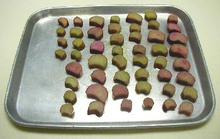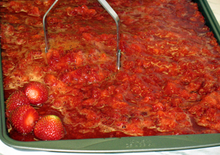Quick facts
- Freeze fruit at peak ripeness.
- Wash fruit and use safe food handling practices when preparing fruit to be frozen.
- Use tested recipes and instructions to ensure a safe and quality frozen fruit.
Why you may want to freeze fruit
Freezing fresh fruit is a type of food preservation that can involve less equipment and time compared to other food preservation techniques. Preserving fruit helps to prevent food loss or waste.
Fresh fruits can have a short shelf life because of ripening enzymes. Ripening enzymes change the texture and taste of fruit. Fruits at peak ripeness are the most flavorful. Fruits such as apples, berries, cherries, grapes, rhubarb and watermelon are picked at peak ripeness and will not continue to ripen. These are called non-climacteric fruits. Fruits such as apricots, melons (cantaloupe or honeydew), peaches, pears, plums and tomatoes will continue to ripen after being picked. These are called climacteric fruits. Freezing fresh fruits at peak ripeness will result in a flavorful preserved food.
Food safety
Fresh fruits contain high amounts of water and natural sugars that can promote spoilage and harmful bacteria growth if not eaten or preserved in a relatively short period of time. Storing fresh fruits in the refrigerator can moderately extend the shelf life by slowing ripening enzymes and growth of bacteria. Freezing fresh fruit significantly extends the shelf life and provides a way to eat fruits when they are not in season.
Freezing fresh fruit at very cold temperatures of 0 degrees Fahrenheit or lower stops the growth of bacteria. It is important to remember that freezing does not kill any bacteria that may be present on the fruit. Use safe food handling practices and properly wash fresh fruits to minimize the risk of cross-contamination before freezing the fruit.
To minimize the risk of bacteria growth, freeze fruits as quickly as possible. To do this, package fruits in quantities of no more than one-half gallon each, and allow enough space around each package in the freezer so the cold air can be in contact with the fruit from many sides. Once the fruit is frozen solid, rearrange the freezer contents so it is tightly packed. Allow up to 24 hours for the fruit to fully freeze.
For the best quality, frozen fresh fruit should be used within 8 to 12 months. Label each package with the fruit contents and the date it was frozen. Safely thaw frozen fruit to minimize the risk of foodborne illness.
How to freeze fruit
Before you freeze fresh fruit, decide what fruit pack methods and techniques you will use. Different methods might be more desirable based on the intended use of your frozen fruit.
Fruit pack methods
Sugar pack
Add granulated sugar to washed and prepared fruit. Gently stir to coat the fruit in the sugar until the sugar is dissolved in the juice from the fruit. Let the fruit rest for 15 minutes before freezing. This method works well with soft, sliced fruits.
Syrup pack
Prepare a syrup according to the recommendations of the National Center for Home Food Preservation. A very light syrup will contain less sugar than a very heavy syrup. Use enough of the chilled syrup to coat the washed and prepared fruit. This method works well for fruits that will be used in desserts.
Unsweetened pack
No sugar or sweetened syrup is added.
For a dry pack, let the washed and prepared fruit completely dry before freezing. This works well for whole berries and rhubarb.
An alternative is to toss the fruit in unsweetened fruit juice or a pectin syrup before freezing. Juices that contain no added sugar and are 100% fruit juice such as apple, white grape, pineapple or orange juice are good options as they won’t change the color of the fruit. A pectin syrup does not contain added sugar and will help some frozen fruit maintain its fresh texture. Refer to the manufacturer instructions on the product label to make a pectin syrup.
Sugar substitutes (aspartame, saccharin, sucralose and stevia or plant derived) or sugar alcohols can be added to fresh fruit before freezing. Follow the serving size usage recommendations on the product label. Lightly coat the washed and prepared fruit.
Using ascorbic or citric acid
Ripening enzymes can cause frozen fresh fruits to brown or change color once thawed. This is due to a change in cell wall structure and a loss of vitamin C. Vitamin C is an antioxidant that in addition to its health benefits, helps to maintain the color of fruits. To stop the enzymes, you can add ascorbic or citric acid to the fresh fruit before freezing.
Fruit juice is a source of ascorbic acid. Bottled lemon juice is a source of citric acid. You can also use commercially prepared mixes or powders that contain ascorbic or citric acid. These can be purchased at many grocery stores or from canning supply stores. Refer to the recipes section for specific acid use recommendations.
Some fruits can be blanched to stop enzyme activity instead of adding an acid before freezing. Blanching is a cooking process where the fruit is added to boiling water for a short period of time, removed from the water, and then rinsed under cold water to stop any further cooking. Firm fruits, such as apples, can be blanched. Refer to the recipes section for specific recommendations.
Freezing techniques
When freezing fruit, use quality containers that are moisture and vapor-proof to prevent freeze burn. Rigid containers made of plastic or glass work well for sugar and syrup-packed fruits. Freezer food storage bags work well for dry-packed fruits. Allow adequate headspace, or room for the fruit and liquid to expand, as it freezes in the container.
Bulk
Fill a container with prepared fresh fruit. Leave enough space for the fruit and liquid to expand as it freezes. This packing technique works well for fresh fruit that is packed in sugar or syrup. As the fruit and liquid freeze, one large block will be formed.
Tray
Place individual pieces of prepared fruit on a tray. Put the tray in the freezer until the fruit is frozen solid. Transfer the frozen fruit pieces to a container. This packing technique works well for unsweetened fruit.
Puree
Process, blend or mash fresh fruit into a smooth consistency. Pour the fruit puree into containers or ice cube trays. Leave enough space for the fruit puree to expand as it freezes. This packing method works well for fruit sauces, such as applesauce, fruit that will be added to smoothies, or in recipes that call for a fruit puree.
Recipes and resources
The National Center for Home Food Preservation is the trusted source for food preservation recipes. The freezing guide contains all of the information you will need to safely preserve a variety of fresh fruits. The recipes include instructions of when to use ascorbic or citric acid, pack method options, and how full to fill storage containers.
The AnswerLine is an excellent resource for answering food preservation questions.
National Center for Home Food Preservation. (n.d.) How do I…Freeze?
Reinhold, Diane. (2021 July). Fill Your Pantry: Freezing Produce. University of Illinois Urbana-Champaign Extension.
Willenberg, Barbara. (2021 January). How to Freeze Fruits. University of Missouri Extension.
Photo credits: National Center for Home Food Preservation, Graphics Gallery
Reviewed in 2023




